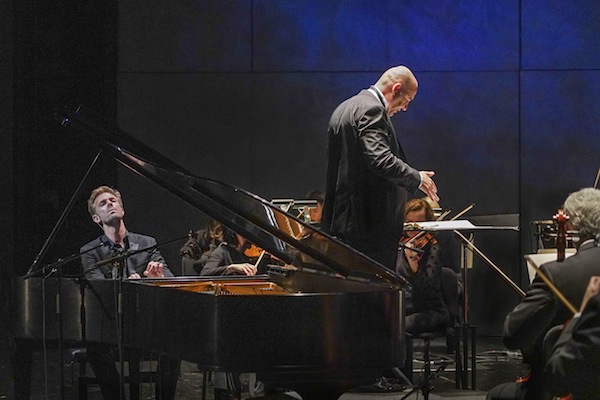Risen from the pit, Dallas Opera Orchestra impresses with Villaume, von Oeyen

Andrew von Oeyen performed Rachmaninoff’s Piano Concerto No. 3 Sunday with Emmanuel Villaume conducting the Dallas Opera Orchestra. Photo; Karen Almond.
The Dallas Opera Orchestra, the heard-but-not-seen ensemble that accompanies everything from established standards to world premieres for the Dallas Opera, came out of the pit and onto the stage Sunday. The concert program offered a pair of favorites by Beethoven and Rachmaninoff with the company’s music director Emmanuel Villaume and guest pianist Andrew von Oeyen at Winspear Opera House.
This is not the first time Villaume has taken this orchestra above the pit; earlier this year, they were onstage together for a series of performances of Korngold’s Violin Concerto with French violinist Augustin Dumay as a preface to Korngold’s one-act The Ring of Polykrates. They had likewise appeared onstage in April 2016 for a performance of Shostakovich’s Symphony No. 13.
Conductor Villaume offered a cheerful pre-concert comment and rationale, explaining that performing in concert expanded the orchestra’s breadth, and made it a more efficient pit ensemble. The performance that ensued demonstrated that, under Villaume’s guidance, the orchestra has much to offer as a concert band in its own right.
In its basic configuration as an accompanying ensemble, the orchestra resembles, in size (with a string section of thirty-one musicians), the reduced forces a major orchestra uses when trimming down for a classical-era work.
Under a newly constructed shell designed specifically for concert performances in the Winspear Opera House, Villaume and the orchestra opened with Beethoven’s Symphony No. 7.
While the lean orchestral sound was somewhat less rich and resonant than one would expect from the Dallas Symphony next door at the Meyerson Center, it was appropriate for an early 19th-century symphonic score. This was evident immediately in the opening bars when, rather than the usual blasts of the first chord, Villaume and the orchestra offered the simple staccato forte Beethoven indicated in the score. From there, the listener could completely bask in the beautifully simple oboe solo, here performed with expansive warmth by principal Rogene Russell.
Within this lightly voiced approach to Beethoven, Villaume revealed—as one might expect from an opera conductor—a sure sense of the drama in this score, parallel to his performances in Dallas Opera’s current run of Mozart’s Don Giovanni. This relatively calm, bombast-free approach yielded the relentless momentum of the Allegretto intact; Villaume, conducting without baton, was not above a little conductorial sleight-of-hand, delivering a quick, almost magical segue from the madcap dance of the Scherzo to the controlled liveliness of the Finale.
Pianist von Oeyen joined Villaume and the orchestra after intermission—and at the opposite end of the romantic era—for the famously passionate and infamously difficult Piano Concerto No. 3 of Rachmaninoff.
Even in that deceptively serene opening passage, von Oeyen and Villaume shared an irresistible intensity created via carefully shaped phrasing and dynamic give-and-take and fairly pronounced rubato. The close musical partnership brought to mind the similar interplay between great conductors and great singers in the operatic works of Rachmaninoff’s contemporary Puccini.
Along with his flawless technique on the keyboard, von Oeyen used damper pedal imaginatively and effectively throughout—sometimes strikingly, as with the light cloud he brushed across the descending arpeggio leading into the final cadenza of the first movement.
He likewise demonstrated and pointed up the sometimes overlooked underlying baroque counterpoint typical of Rachmaninoff’s orchestral scores, finding the scraps of fugues and other contrapuntal devices lurking within his rich romantic textures.
Together, conductor and pianist created the inexorable tidal pull of the final movement, landing on the cathartic final phrase with that combination of surprise and inevitability—in this performance, tinged with elegance—that this concerto evokes when all elements are in place.